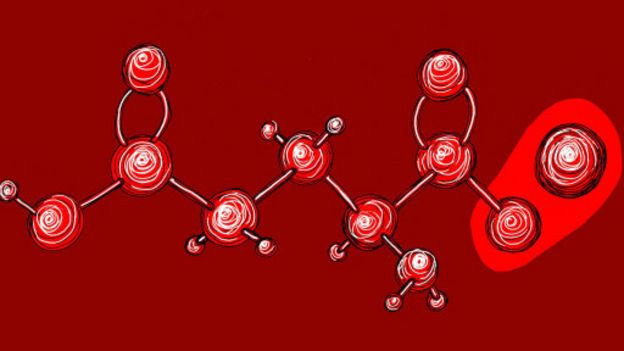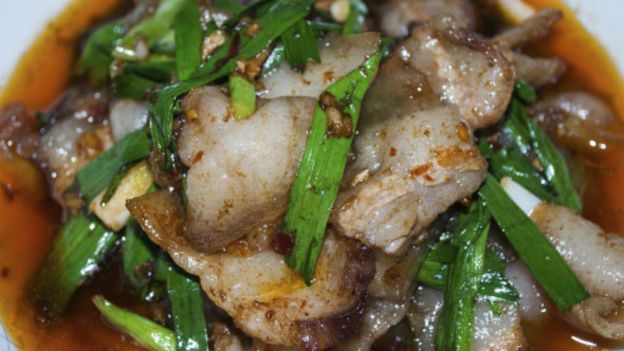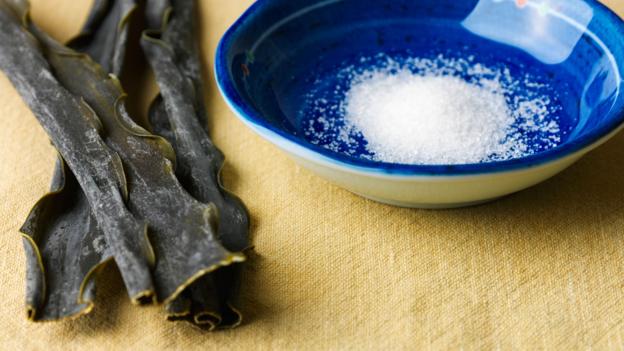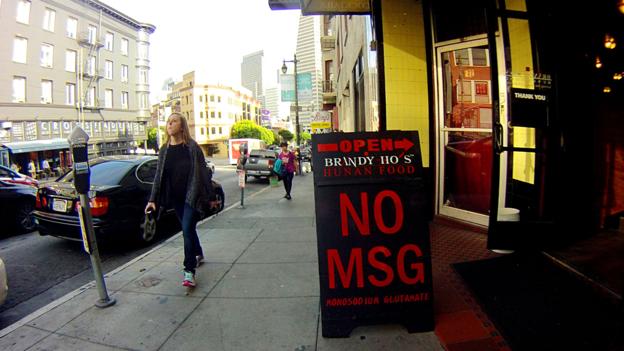味精真的有害健康吗?
BBC比安卡·诺格拉迪(Bianca Nogrady)(2023年12月3日)

谷氨酸钠是谷氨酸盐最稳定的形态,也是最受欢迎的鲜味剂(图片来源:Claudia Stocker/Science Photo Library)
有一种现象叫做“中餐馆综合征”,它指的是某些人在吃完中餐后会出现许多古怪的症状,包括头痛、恶心、麻木。这种感觉与吃多了叉烧包后出现的正常恶心有所不同。有人认为,这种症状的罪魁祸首是一种名为谷氨酸钠的常用调味料,也就是我们常说的味精。
谷氨酸钠的恶名始于1968年。当时,郭浩民博士给《新英格兰医学期刊》(New England Journal of Medicine)写了一封信,阐述了他在美国的中餐馆就餐后出现的一种综合征,并分析了可能的原因。据他描述,当他吃完中餐后,脖子后面有些发麻,然后扩大到胳膊和背部,而且感觉全身虚弱,甚至伴有心悸。
郭浩民怀疑罪魁祸首可能是酱油——但由于他在家里做饭时使用酱油后并没有出现这种现象,所以排除了这种可能——也有可能是餐馆里使用料酒时的用量过于随意。后来就有了上文提到的这个观点:原因可能出在中餐馆里常用的味精。就像很多与食品相关的健康理论一样,他的这个观点很快传播开来,并催生了许多科学研究,以及大量关于味精“真相”的书籍和反对使用味精的烹饪书,甚至还有很多中餐馆以不使用味精作为宣传噱头。
味精就是谷氨酸钠,它是由日本东京大学化学教授池田菊苗1908年发现的,是一种最稳定的谷氨酸盐,也是最受欢迎的鲜味剂。
鲜味与肉的味道密切关联,这同样是由池田菊苗发现的。他认为,除了酸、甜、苦、咸四种基本味道之外,还有其他味道存在。
谷氨酸是味精中的神奇原料。这是一种常见的氨基酸,很多食物中都包含这种物质,包括番茄、帕玛森奶酪、干蘑菇、酱油、各种水果和蔬菜,以及母乳。
“在郭浩民的信寄出后,出现了很多针对各种动物进行的实验,并且都使用了大剂量的谷氨酸钠。”
池田菊苗从干海带中分离出了谷氨酸——干海带是他的妻子以及世界各地的所有日本人制作日式上汤时的必备原料——加入钠(食盐的两大主要成分之一)之后便可让谷氨酸成为稳定的粉末状,然后加入到食物中,便得到了谷氨酸钠。池田菊苗因此赚了很多钱。他以谷氨酸钠为基础制作了名为“味之素”的调味料,也就是我们常说的味精。而如今,味精已然风靡全球。
在郭浩民的信寄出后,出现了很多针对各种动物进行的实验,其中也包括人,并且都使用了大剂量的谷氨酸钠——有的通过静脉注射,有的通过口服。
起初,郭浩民的说法似乎得到了验证。华盛顿大学的约翰·W·奥尔尼(John W. Olney)博士发现,向刚出生的老鼠皮下注射大量谷氨酸钠会导致其大脑形成许多的坏死组织。当这些老鼠成年后,便会出现发育不良和肥胖等问题,有些还会不育。奥尔尼还在幼年猕猴身上重复了这项研究,给它们口服谷氨酸钠,并发现了相同的结果。但其他研究人员针对猴子展开的另外19项研究却未能得出相同甚至相似的结果。
针对人类进行的研究似乎也没有得出确凿的证据。在一项研究中,71名健康人以胶囊的形式口服了大剂量的谷氨酸钠或安慰剂。研究人员发现,摄入谷氨酸钠和安慰剂的两组志愿者出现所谓的中餐馆综合征症状的比率几乎相同,即使是在相互交换后同样如此。
为了平息争论,美国食品和药品管理局(FDA)1995年委托美国实验生物学联合会对所有可用的证据进行研究,并判断谷氨酸钠究竟是不是很多人所认为的有害食品。一开始,专家组就放弃了中餐馆综合征这样的说法,代之以“谷氨酸钠症候群”的称谓,用于描述与摄入谷氨酸钠有关的多种症状。

与摄入谷氨酸钠有关的一组症状曾经被称作“中餐馆综合征”(图片来源:Thinkstock)
但他们的确认为,有足够的科学证据证明,在普通大众中确实有一部分健康人可能因为摄入大量谷氨酸钠而产生不良反应,通常会在1小时内出现。但这些反应是在他们用水送服3克甚至更多的谷氨酸钠时发生的,而且没有食用任何食物;FDA表示,这种情况在现实世界中不太可能发生,多数人每天通过饮食摄入的谷氨酸钠大约只有0.55克左右。
2000年的一项调查进一步探究了这一问题,研究对象是130名自称对味精有反应的人。这些原本健康的人首先在不进食的情况下摄入了一定剂量的谷氨酸钠或安慰剂。研究人员共列出了10种症状,如果有人的症状超过一定程度,就会让其再次服用同等剂量的谷氨酸钠或安慰剂,以确定他们的反应是否一致。他们还会接受更大剂量的测试,以了解其症状是否会更加明显。在经过了另外一轮重复测试后,最初的130人只有2人对谷氨酸钠(而非安慰剂)表现出一致的反应。但随后,在进食状态下测试时,他们的反应却有所不同——这便令人产生疑问:他们自己所谓的谷氨酸钠过敏究竟是否属实。
“谷氨酸盐的毒性极低。”
然而,谷氨酸盐的毒性极低。以老鼠为例,每千克体重摄入15至18克谷氨酸盐才有可能中毒身亡。而目前已知的情况是,幼鼠对谷氨酸钠尤其敏感。
所以,尽管无法从科学上完全消除人们的顾虑——奥尔尼博士也在他早期的动物实验后花费了很多时间呼吁对味精的使用加强监管——但FDA现在还是认为,向食物中添加味精是“基本安全的”。
这对很多喜欢中餐的人来说是一种宽慰。在他们看来,如果不围着圆桌吃上一顿加了很多酱油的中餐,肯定不能算是一个完整的周末。
Is MSG as bad as it’s made out to be?
By Bianca Nogrady,3 December 2024
It used to be called ‘Chinese Restaurant Syndrome’: a collection of symptoms such as headache, nausea and a strange numbness that certain people seem to suffer after a meal of Chinese food, which went beyond the usual queasiness and self-loathing at having eaten one too many barbecued pork buns. The ingredient allegedly to blame is a commonly used seasoning called monosodium glutamate, better known as MSG.
Monosodium glutamate’s notoriety took off in 1968 when Dr Ho Man Kwok wrote a letter to the New England Journal of Medicine musing about the possible causes of a syndrome he experienced whenever he ate at Chinese restaurants in the US. In particular, he described a feeling of numbness at the back of his neck that then spread to his arms and back, as well as general weakness and heart palpitations.
As food-related health theories are wont to do, his suggestion went viral
Kwok speculated the cause could be soy sauce – but dismissed this as he used it in home cooking without the same effects – or the more liberal use of Chinese cooking wine in commercial establishments. Then came the clanger: perhaps it was the monosodium glutamate used as a common seasoning in Chinese restaurants. As food-related health theories are wont to do, his suggestion went viral, spawning a huge number of scientific studies, books exposing ‘the truth’ about MSG, anti-MSG cookbooks, and even prompting Chinese restaurants to advertise that they didn’t use MSG in their cooking.

Kikunae Ikeda isolated glutamate from kombu seaweed, and added sodium to create monosodium glutamate (Credit: Mariano Montero/Alamy)
‘Umami’ – which translates as ‘savoury’ – is associated with a “meaty” flavour, and was also Ikeda’s discovery, who pursued it believing that there was something more than the four basic tastes of sweet, salty, sour and bitter.
Glutamate is the magic ingredient in MSG. It’s a common amino acid that occurs naturally in a large range of foods including tomatoes, parmesan cheese, dried mushrooms, soy sauce, a host of fruits and vegetables, and human breast milk.
After Kwok’s letter, a flurry of experiments followed in which various animals were subjected to large doses of monosodium glutamate
Ikeda isolated it from the dried kombu seaweed (kelp) that his wife – and just about every other Japanese cook on Earth – used to make the dashi stock that is ubiquitous in Japanese cuisine. Adding sodium, one of the two elements in table salt, allows the glutamate to be stabilised into a powder and added to food, thus giving us monosodium glutamate and making Kikunae a very rich man. His MSG-based condiment, Ajinomoto (‘essence of taste’) is now found on tables the world over.

Kikunae Ikeda’s MSG-based condiment, Ajinomoto (‘essence of taste’) is now found on tables the world over (Credit: Richard Masoner/Cyclelicious/Flickr/CC BY-SA 2.0)
At first, it looked like Kwok might have been onto something. Washington University researcher Dr John W. Olney found that injecting enormous doses of monosodium glutamate under the skin of newborn mice led to the development of patches of dead tissue in the brain. When these mice grew into adulthood they were stunted, obese, and in some cases, sterile. Olney also repeated his study in infant rhesus monkeys, giving them the MSG orally, and noted the same results. But 19 other studies in monkeys by other researchers failed to show the same, or even similar results.

Fears about side-effects have prompted some restaurants to advertise that they don’t use MSG (Credit: Richard Masoner/Cyclelicious/Flickr/CC BY-SA 2.0)
In an attempt to lay the issue to rest, in 1995 the US Food and Drug Administration (FDA) commissioned the Federation of American Societies for Experimental Biology to look into all the available evidence and decide whether MSG really was the food fiend that it was made out to be.
To begin with, the expert panel dismissed the term ‘Chinese Restaurant Syndrome’ as “pejorative and not reflective of the extent or nature of the symptoms”, choosing instead the term ‘MSG symptom complex’ to describe the many and varied symptoms linked to consumption of MSG.
But they did conclude there was enough scientific evidence to suggest the existence of a subgroup of healthy individuals in the general population who may respond badly to large doses of MSG, usually within an hour of exposure. But these reactions were observed in studies where they were given three grams or more of MSG delivered in water, without food; a scenario unlikely to occur in the real world where, according to the FDA, most people will get around 0.55 grams per day of added MSG in their diet.
A study in 2000 tried to explore this further with 130 people who described themselves as being reactive to MSG. These otherwise healthy people were first given a dose of MSG without food, or given a placebo. If anyone scored above a certain level on a list of 10 symptoms, they were tested again with the same dose (or placebo) to see if their response was consistent. They were also tested with higher doses to see if this increased their symptoms. After another round of retests, only two of the original 130 had shown consistent reactions to MSG and not the placebo. But then, when they were tested again with MSG in food, their reactions differed – which cast doubt on the validity of self-described MSG sensitivity.
Glutamate is remarkably low in toxicity
But otherwise, glutamate is remarkably low in toxicity. A rat or mouse can take a dose of 15-18 grams per kilogram of body weight before it is at risk of dying from glutamate poisoning. It’s also now known that baby mice are particularly sensitive to the effects of MSG.
So while nothing is ever truly laid to rest in science – and Dr John Olney spent much of his life after his early animal experiments campaigning for tighter regulation of MSG use – the FDA now says the addition of MSG to foods is GRAS, or ‘Generally Recognised As Safe’.
It’s reassurance to the many fans of Chinese cuisine, for whom a lazy weekend just isn’t complete without a few spins of a soy sauce-spattered lazy Susan.